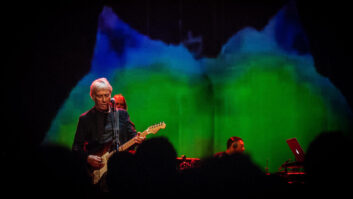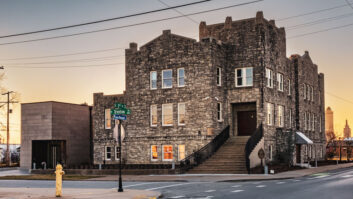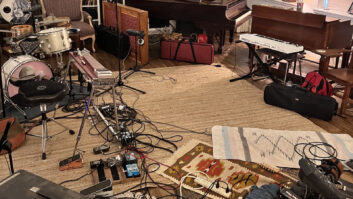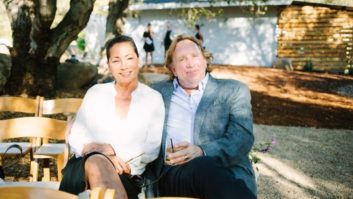You may recall the advertising slogan that the late, great film director-turned-pitchman Orson Welles used to solemnly intone — “We’ll sell no wine before its time.” Well, that phrase could just as easily refer to the enigmatic, mellow-rocking singer/songwriter J.J. Cale’s musical output. It’s been more than five years since his last studio CD, Guitar Man, was released. And much to the dismay of his devoted fans and Virgin, his very patient record company, it may be quite a bit longer before he comes back with new material. But Cale fans do have something to cheer about these days — J.J. Cale Live on Back Porch Records, a subsidiary of Virgin. It’s a collection that mixes some of Cale’s best-known songs with lower-profile, highly personal numbers performed in different concert settings, ranging from small theaters to large concert halls in the U.S. and Europe. Cale is a notoriously reclusive musician who rarely does interviews, took 25 years before even attaching his pictures to any of his records, and performs only sporadically, so this is about as good as it can get for right now. The recorded appearances date from April 1990 to March 1996 — not exactly recent tours, but representative nonetheless.
Despite Cale’s laconic, laid-back manner, much of his live CD has a surprisingly rollicking feel to it. Still, “a lot of the selections are more acoustic-based,” says John Wooler, senior VP of Virgin Records, from his office in Los Angeles. He does A&R for the associated Virgin labels and has worked with the publicity-shy artist since the early ’90s. “It contains ‘Magnolia,’ which I personally like a lot, and things like that, which are different. Which is good because a lot of people who know the songs don’t know that Cale wrote them. People think ‘After Midnight’ and ‘Cocaine’ are Clapton songs. Even ‘They Call Me the Breeze,’ many think it is by Lynyrd Skynyrd.” Wooler notes that many of the live versions differ considerably from their studio counterparts.
Paul McManus, who recorded 13 of the 14 tracks on the CD, adds, “It’s laid out just like one of his stage sets, even though it was recorded all over the place. That was something he really wanted to capture. And, really, that was the whole point of it. With the pacing and moods of the songs, listening to it is just like being at one of his shows.”
The engineer, who describes himself as a “fixer-mixer,” met Cale, who also produced the CD, totally by coincidence at his home in San Diego. Before working with Cale, McManus’ recording experience was mostly with local musicians. He was recommended to Cale by Coast Recorders in Hollywood to repair his Ampex 1-inch 8-track deck in 1989. The native San Diegan was able to do the needed work rather easily. And when he finished, the two of them started talking about equipment and music. It turns out that Cale is actually a bit of a technology buff, so with that as a mutual interest they developed a friendship. A few years later, Cale asked McManus if he wanted to tag along with him to San Francisco while he produced John Hammond’s Trouble No More CD. The engineer didn’t work directly on the project, but he ended up being a consulting engineer.
Once they returned to San Diego, they played around doing recordings on McManus’ Universal Audio vacuum-tube mixing console. It’s quite a historic piece of equipment, and was recently on display at the AES conference in Los Angeles. McManus recalls that in 1993, after getting to know each other pretty well, Cale said to him, “I’d like to make a ‘live’ album, and I’d like for you to get involved with it. I’ve made every kind of record out there, but I haven’t made a live one. So figure out what we need and let’s do it as small as we can.” McManus was caught offguard. “My reaction was surprise and when do we start?” he recalls from his home studio in San Diego.
“Over the years, he had made dozens and dozens of live recordings,” says the engineer. “Everywhere he played, they threw up two mics, or something. They used every format known to man then, from cassette to analog reel-to-reel. ADAT and DAT were just on the verge of coming out then. He’d even done a lot of stuff on a PCM F-1.” But much of it was done casually or on-the-fly, and, consequently, wasn’t of good enough quality to be used for a bona fide release — only “Ride Me High,” recorded in 1990 before McManus got involved, made the cut for the J.J. Cale Live CD.
Although Cale has a good knowledge of equipment and techniques, he entrusted all of the project’s technical aspects to McManus. “J.J. had worked as an engineer back in the ’60s with Snuff Garrett, Leon Russell, and Delaney & Bonnie while coming up in Tulsa, Oklahoma,” he notes. “He’s spent a lot of time in recording studios all over the place, and also worked on Blue Cheer’s ‘Summertime Blues.’ He has a good background, so if I told him I was having a problem with gain, mic qualities or other things, he knew what I was talking about. But he basically gave me free reign. I’d discuss everything with him, showing him block diagrams and things like that, which he found interesting. I guess the best word to describe him is insightful — he has a real good grasp of trends and where things are going. He could discuss things in engineering terms as well as artistic. There are few artists that could do that.”
The whole equipment setup to record Cale live fit into four road cases. McManus’s basic gear consisted of a Tascam DA-88, a Sony DAT and a Mackie 1604 mixer. “We chose the DA-88 primarily because you could record for more than 40 minutes on it,” he remembers. “The earlier ADATs were limited to that. Prior to that, I just mixed live to DAT. The Mackie 1604, which is quite common now, was brand-new then. However, it only had six mic preamps. To get 10 more, we had to buy this box called an XLR-10 adapter and bolt it to the bottom of the board.”
Other modifications included using two 4-channel splitter boxes with Reichenbach transformers. That enabled McManus to go directly from the stage mics and get a direct, isolated one-to-one feed. His insert jacks were used as direct outs so his pre-faders could feed the DAT and not need the faders to control his record levels.
Overall, the whole affair was rather homespun. However, quality was still essential and is one of the reasons why the CD took three years to compile while McManus was involved. Those years were not intensive, though. “We’d go out for about a week every other month or so,” the engineer recalls. “We could literally be anywhere when he performed, from a small club, being outdoors in a circus tent, an outdoor festival or a grand concert hall. You never knew where you would be next, and that kept it interesting.
“Also, it was rare for me to be involved with a musician who would never play a song the same way twice. He would always keep you guessing. Plus, you didn’t always know who would be performing or not be performing with J.J. He had a core band, but he has a lot of friends who’d stop by and sit in. He’d say, ‘Hey Paul, we’re adding a couple guys here,’ and I’d say, ‘No problem.’ The track layout consisted of one each for J.J.’s vocals, J.J.’s guitar, drums, bass, rhythm guitar and keyboard. Then I had a pair of Neumann U87s in omni position on both sides of the stage. They were always set up between the stage monitors and the front of house. Basically, I was trying to pick up the whole room in a stereo perspective, kind of a spaced-omni perspective.”
Preliminary mixing for the CD came down to the artist’s and engineer’s personal perspectives. Each would do mixes on various versions from the narrowed-down list of songs — sometimes numbering six or seven recordings of the various tunes. Naturally, their respective end results sometimes wound up being quite different. Ultimately, Cale decided which ones he thought worked best, and then he did the final mix on each song. On the album sleeve, the producer is listed as Mike Test, one of a long line of pseudonyms Cale has used for himself and even some of his musicians.
“He’s too embarrassed to say he did it himself, and he really is a humble man,” comments Virgin’s Wooler. “Sometimes, he wonders what all the fuss is about and plays down his contribution to music. He’s not the kind of artist you can bully into recording, though. You have to let him do it when he feels it. He’s definitely unique.”
As for engineer McManus, “The whole experience was definitely one of the high points of my 25 years in audio,” he beams.






